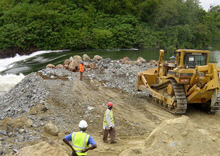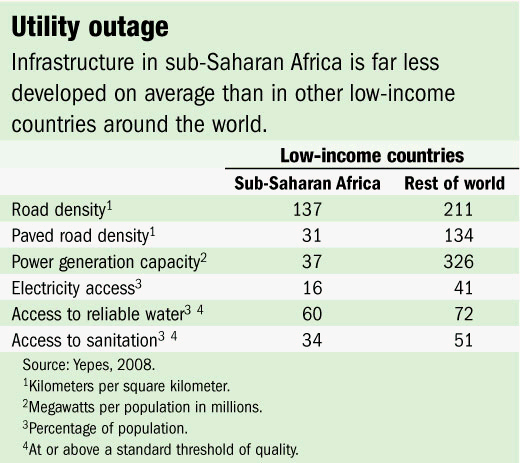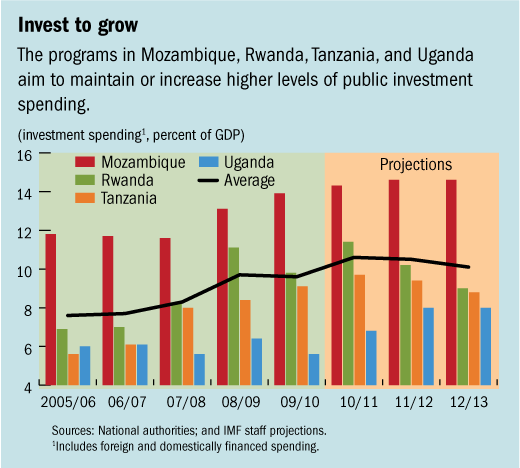
Typical street scene in Santa Ana, El Salvador. (Photo: iStock)
IMF Survey: New Financing Sources for Africa's Infrastructure Deficit
July 21, 2010
- Bigger infrastructure gaps in sub-Saharan Africa than in other low-income countries
- Well targeted investment in infrastructure can raise Africa's growth potential
- IMF-backed programs aim at enabling more public spending for infrastructure
Four African countries are seeking to boost their infrastructure budgets with new and nontraditional financing sources as they chase higher economic growth rates.

Dam construction in Uganda. Studies show infrastructure gaps constrain growth in low-income countries of sub-Saharan Africa (photo: AFP/Getty Images)
POLICY SUPPORT INSTRUMENT
Policy programs in Mozambique, Rwanda, Tanzania, and Uganda allow for less concessional financing from multilateral development banks and export credit agencies; more use of public-private partnerships; and, potentially, external sovereign bond issues—as long as the new approach does not endanger fiscal and external debt sustainability.
Programs for the four countries approved since 2006 under the IMF’s Policy Support Instrument focus on macroeconomic and structural policies aimed at scaling up infrastructure spending. Policy packages for Mozambique, Rwanda, Tanzania, and Uganda reflect studies by development partners that show infrastructure spending is critical for enhancing growth and maintaining momentum toward achieving the United Nations Millennium Development Goals.
Numerous recent assessments by the IMF, multilateral development banks, and think tanks have shown how disproportionately large infrastructure gaps serve as a binding constraint to higher factor productivity and growth in low-income countries in sub-Saharan Africa. Infrastructure in the region is far less developed on average than in other low-income countries around the world, particularly in the areas of power and transportation (see table).

The World Bank has estimated that if sub-Saharan Africa’s low-income countries had an infrastructure base equivalent to a medium income country such as Korea, average per capita growth would be higher by 2.6 percentage points per year. Higher transportation, water, and power costs in Africa’s low-income countries are estimated to dampen private sector productivity by almost half —as much as crime, corruption, and limited financial market access combined.
Mozambique, Rwanda, Tanzania, and Uganda all face critical infrastructure gaps, including in the energy and transportation areas. Addressing those gaps is a central objective of the policies established under each country’s Policy Support Instrument-backed program. Each program aims at roughly maintaining or increasing higher levels of public investment spending achieved in recent years (see chart), buttressed by fiscal and structural reforms and the maintenance of a stable macroeconomic environment.
Expensive business
Investing in infrastructure is expensive. The estimated cost of bringing sub-Saharan Africa’s low-income countries’ infrastructure up to the level of other low-income countries and maintaining it ranges from 10–30 percent of current GDP. However, projected official development assistance, a traditional source of budget finance in Africa, while remaining an important source of financing, is unlikely to be sufficient to support maintaining higher public investment levels.

In the four East African countries with new Policy Support Instrument programs, on average, official aid has not increased in line with public investment spending and is not projected to do so in the next three years. New financing sources must be tapped if public investment is to be maintained or scaled up.
IMF facilities to low-income countries have been adapted to take this new priority into account. For example, since December 2009 IMF-supported programs in countries with healthy debt indicators and sufficient debt management capacity may include access to external borrowing on terms that do not meet the conventional standard of concessionality (a grant element of at least 35 percent).
New options
Previously, Fund programs with low-income countries allowed only nonconcessional external borrowing in exceptional circumstances. The change will enable countries to supplement traditional concessional assistance with new sources of financing, including less concessional financing from multilateral development banks and export credit agencies; more use of public-private partnerships; and, potentially, external sovereign bond issues—as long as it does not endanger fiscal and external debt sustainability.
Mozambique, Rwanda, Tanzania, and Uganda are deemed to be at low-to-moderate risk for debt distress and to have broadly adequate, albeit still rudimentary, public financial and debt management capacity. Their Policy Support Instrument-supported programs include potential nonconcessional external borrowing in amounts ranging from 2.4 to 7.5 percent of GDP over three years, which would be aimed at stepping up public investment.
Updated World Bank-IMF debt sustainability analyses suggest that, even using the most conservative assumptions for financing terms, such borrowing would increase the debt burden, but the countries would remain at low risk (although Rwanda would remain at moderate risk) for debt distress.
High returns
Another important issue is to ensure that new public infrastructure investment, however financed, has a strong positive net return for growth. To that end, the Policy Support Instrument programs embed a broad range of structural reforms aimed at boosting the efficiency of public investment spending and of public financial management more generally. These range from better linking budget planning and implementation, to setting up effective assessment and monitoring frameworks for public-private partnerships, to controlling accumulation of budgetary arrears. Similarly, the programs include measures designed to enhance debt management capacity so that evolving borrowing strategies remain fully consistent with fiscal and debt sustainability.
The growth return to public infrastructure investment also depends on a robust private sector response. The four countries are undertaking various reforms to develop a supportive investment climate, reduce corruption, and strengthen legal frameworks. They also seek to expand access to well regulated financial services through enhancing supervision, including of innovative financial instruments such as mobile banking.
Domestic resources
The Policy Support Instrument programs also contain measures to enhance domestic revenue intake significantly, both through administrative improvements and policy reforms. Uganda and Rwanda still have very low levels of revenue collection, at around 12.5 percent of GDP. Mozambique and Tanzania’s ratios have increased in recent years, but at roughly 16–17 percent of GDP, remain low by international standards.
Streamlining tax exemptions and stronger enforcement should allow for continued increases in the tax revenue effort in all four countries, on average by at least 1.5 percentage points of GDP by the third program year. In some cases, there is also scope for rationalizing some low-priority spending that has increased significantly in recent years, such as allowances paid to public servants.
Shift from aid dependence
Well designed and well targeted investment in infrastructure can raise Africa’s growth potential and maintain momentum toward Millennium Development Goals achievement. The new Policy Support Instrument programs not only aim at increased public spending for growth-critical infrastructure, they also focus on enhancing debt management capacity, optimizing public spending efficiency, expanding access to financial services, and creating a strong investment climate.
As these “frontier” economies transition away from aid dependency, these tools can support more self-sufficient public financing options and increased reliance on private sector-led growth.


